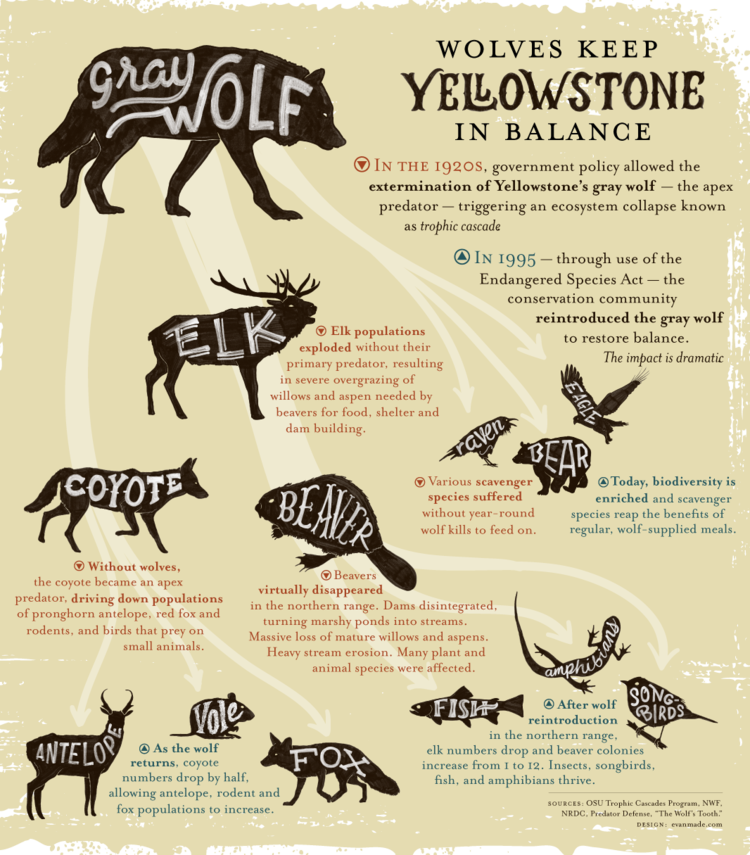Digital Marketing Ecosystems and Nature’s Balance
Wolves’ Impact On Yellowstone Ecosystem
In nature, an ecosystem is a biological community of interacting organisms and their physical environment. In business, an ecosystem is a complex network or interconnected systems. The components of nature-based and business-based ecosystems are different, but the underlying construct of each is the same.
As an example, consider the natural ecosystem of Yellowstone National Park.
National Geographic recently published an article on the impact wolves have had on the natural ecosystem of the park. Over the years, the wolves – which are alpha, or top-of-the-food-chain, predators – had been completely eradicated from the park by hunters for sport, and by ranchers seeking to protect their livestock. Once the wolves were removed from the ecosystem the park began to change. The elk population exploded as it grazed freely on young brush and trees. The number of small rodents and birds decreased because there were fewer insects to feed on the brush, trees and flowers. The lack of brush contributed to a higher rate of erosion along riverbanks.
In short, once wolves were removed from the food chain the rest of the natural ecosystem began to deteriorate.
In 1995, when the wolves were re-introduced to the park, a funny thing started to happen over the years that followed. Many of the animals and plant life started to come back. The brush, trees and flowers returned because the elk population dropped, and the elk moved more when they grazed. The change increased the number of insects, which then brought back more birds that feed off the insects. Beavers made a comeback too and started to build damns, creating additional micro-ecosystems inside the larger ecosystem of the Park.
Search Engines Impact on Digital Marketing Ecosystems
Similar to Yellowstone Park, a successful digital marketing ecosystem is fragile and depends on the diversity of its strategies to survive. If you remove one channel of the ecosystem, its absence can have a significant impact downstream – even if you do not see a one-to-one correlation.
Whether it is the diversity of your content or the mix of marketing tactics you use – each element contributes in a different way to the success of the entire ecosystem. The most experienced marketers understand that there is a balance and that optimization and continued development are the cornerstones of this balance.
Take for example search marketing – the proverbial wolf in this story. Not including search in your marketing ecosystem will likely result in an untold number of missed opportunities. All campaigns should be leveraging this inbound marketing tactic, regardless of whether or not you are getting direct conversions. Why? Because search marketing (both paid and organic) is the most common form of advertising your audience will use to connect with your brand. Search marketing is the alpha predator of digital marketing ecosystem – remove it, and all the other tactics will struggle to survive.
Don’t believe me? Try running a few search campaigns on Google AdWords for a measurable time frame. Use keywords that relate to your offerings – make sure you use your branded terms as well. Then, review the results of the activity generated on other channels during that time frame. The most obvious observation you will notice is that there is a larger number of people visiting your website. You will also notice people visiting and following your social media pages. You will likely also see an increase in people purchasing your products, signing up to receive your newsletter or filling out your “Contact Us” form. Point is, there are a number of untold opportunities from search – and that it may not be directly related to social but can have an indirect impact.
As stated earlier, search engines are typically the first place current and potential clients go to learn about your brand. There are 3.5 billion searches on Google every day, which equates to 1.2 trillion searches per year worldwide. If your business is not showing up for even a fraction of these searches, you are missing out.
Social media is no different. With more than two billion active users, Facebook is by far the most widely-used social media platform. 79% of Americans use Facebook, with the next closest platform being Instagram (which is owned by Facebook) at 32%. LinkedIn has 250 million active users worldwide and 40% of Americans use the platform daily.
The examples above are just a few of the many distribution channels that can be leveraged in a marketing campaign. As a marketer, it’s your responsibility is to find the right mix of these channels to ensure your ecosystem remains robust and in balance. If you remove any one element of your ecosystem, the change could have an indirect but significant impact on the entirety of the system. It may not always be immediately apparent, but the various channels of your marketing system – just like the different members of Yellowstone’s biological ecosystem – depend on each other to prosper, or even to survive. The more robust the ecosystem, the more robust – and ultimately successful – your campaign will be.

